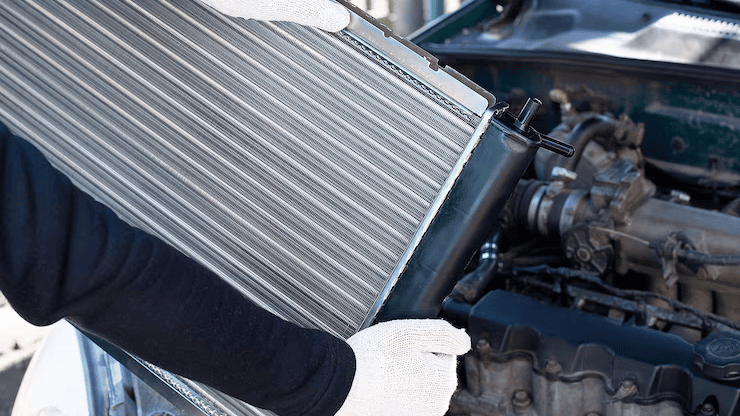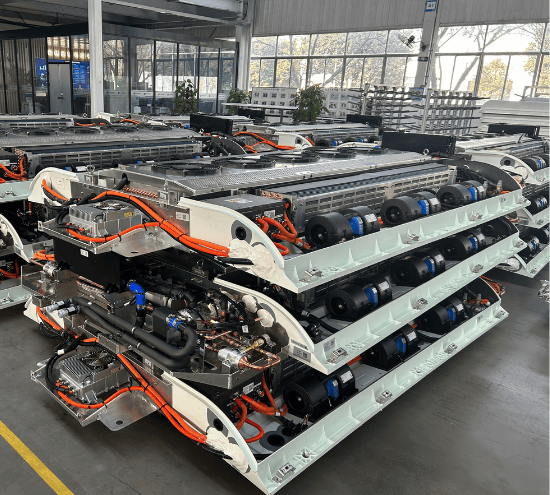The
car radiator is the core component of the engine cooling system, responsible for dissipating the heat generated by the engine into the air, ensuring the engine operates at an appropriate temperature. Once the radiator malfunctions, it can lead to engine overheating at the mild end or severe engine damage at the extreme.
Today, we will take a detailed look at the common symptoms, causes, and emergency handling methods of radiator failure.
1、Common Symptoms of Radiator Failure
Abnormal Engine Water Temperature
High water temperature: Radiator blockage, damaged radiator fins, fan failure, insufficient or degraded coolant, etc., can all cause the engine water temperature to rise. For example, when the radiator is blocked, the coolant cannot circulate normally, causing the water temperature to rise sharply; if the radiator fan does not work or operates at a low speed, it cannot effectively dissipate heat, also resulting in high water temperature.
Low water temperature: This may indicate a radiator leak, causing coolant loss and preventing the cooling system from functioning normally, leading to low water temperature.
Coolant-Related Abnormalities
Coolant leakage: Damage, aging, or loosening of the radiator pipes, joints, or core tubes can cause coolant leaks. Leaking areas may show visible water marks, and in severe cases, the coolant level will significantly drop.
Coolant deterioration or discoloration: If the coolant is not replaced for a long time, or if chemical reactions occur inside the radiator, the coolant may deteriorate or change color, such as turning milky white or black, which affects its heat dissipation and anti-corrosion performance.
Engine Performance Decline
Power reduction: Radiator failure leading to engine overheating can reduce combustion efficiency, resulting in weakened engine power, sluggish acceleration, and difficulty climbing hills.
Increased fuel consumption: Engine overheating causes incomplete fuel combustion, increasing fuel consumption. Meanwhile, to maintain normal engine operating temperature, the vehicle may automatically adjust certain parameters, further increasing fuel consumption.
Abnormal Sounds or Odors
Abnormal sounds: Poor coolant flow or foreign objects in the radiator may produce unusual water flow or bubbling sounds. If the radiator fan malfunctions, abnormal buzzing or squeaking noises may also occur.
Odors: Radiator failure causing coolant leakage or engine overheating may produce burning smells or rubber odors.
Dashboard Warning Lights
Water temperature warning light on: This is the most direct indication that the engine water temperature is too high and the radiator may be malfunctioning.
Other related warning lights on: Such as the oil temperature warning light or engine fault light, may also be related to radiator failure, as it can affect other engine components and systems.
2、Common Causes of Car Radiator Failure
Internal Blockage
Sediment accumulation: Coolant contains impurities such as metal fragments and dust, which over time can accumulate inside the radiator tubes, gradually blocking the waterway and hindering normal coolant circulation.
Coolant mixing: Mixing different brands of coolant may cause chemical reactions, producing white crystals that easily block the narrow radiator waterways, obstructing coolant circulation.
External Leakage
Core tube damage: Over long-term use, radiator core tubes may be damaged due to aging, corrosion, or external impact, resulting in coolant leakage. Leaks commonly occur at corners and the outer layers of the core.
Loose connections: Aging, damage, or improper installation of seals at radiator connections with hoses, caps, etc., can cause loosening and lead to leaks.
Poor Heat Dissipation
Fan failure: Fan motor damage, deformed or broken fan blades, or fan controller malfunction can cause the fan to not operate properly or at abnormal speed, affecting radiator cooling performance.
Dirty radiator surface: Accumulation of dust, oil, or dirt on the radiator surface can block airflow, reducing heat dissipation efficiency.
Insufficient coolant: Low coolant levels result in insufficient coolant in the radiator, unable to fully remove engine heat, leading to poor cooling.
Corrosion Issues
Electrochemical corrosion: Antifreeze and hose materials may undergo replacement reactions, forming a path from coolant to grounding points, which can accelerate hose corrosion and affect radiator function.
Acidic corrosion: Excessively acidic coolant can corrode the radiator metal parts, reducing its lifespan and heat dissipation performance.
3、Emergency Handling of Radiator Failure
Radiator Core Tube Blockage
Check temperature difference: Use an infrared thermometer to detect the temperature difference between the radiator inlet and outlet. The
radiator inlet temperature is the engine coolant temperature, and the return pipe temperature should be 20–30℃ lower. If the return pipe temperature is too low, it indicates radiator blockage.
Observe surface temperature: If accessible, use an infrared thermometer to measure radiator surface temperature. If the middle of the radiator is hotter than the edges, the lower radiator water pipe is likely blocked.
Clean the radiator: Before cleaning, drain the original coolant, remove the thermostat, then add a specialized radiator cleaning solution according to the radiator material. Start the engine at idle for 30 minutes, then stop for 2 hours. Restart the engine, varying RPMs to utilize water impact force to clean scale and sediment in the coolant system. Run for 10–15 minutes, then stop and drain the mixed cleaning solution. Once slightly cooled, add water, run the engine at medium speed for 4–5 minutes, then drain. Repeat 3–5 times until the water is clean. Finally, reinstall the thermostat and refill standard antifreeze.
Radiator Leakage
Check the leak location: Leaks are commonly at corners and outer core tubes. Pour hot water into the radiator to check for leakage. Alternatively, plug all radiator hoses and outlets except one connected to an air supply, and use a compressor or pump to pressurize the radiator. Observe if bubbles appear.
Repair leaks: Depending on the damage location and severity, different repair methods can be used. Small leaks can be soldered with tin, aluminum, or copper depending on radiator material. If leaking core tubes are less than 5%, welding repair is suitable; if less than 10% of total core tubes, blocking the top and bottom of the tubes may be used; if more than 15%, the entire
radiator assembly should be replaced.
4、How to Prevent Radiator Failure
Regularly check coolant: Replace every 2 years or 40,000 km, and ensure the level is correct.
Clean the radiator: Use a professional cleaning agent every 2 years to remove scale and debris.
Check fan and belts: Ensure electric fans operate normally and water pump belts are not aged.
Avoid low-quality antifreeze: Inferior coolant can corrode the radiator.
Keep radiator exterior clean: Regularly clean dust and debris from radiator fins.
5、Car Radiator Common Questions and Answers
- Which is better, an aluminum or steel radiator?
Aluminum radiators, with their obvious advantage in lightweight materials, have gradually replaced copper radiators in passenger cars and light vehicles. Most radiators supplied passenger cars are aluminum, mainly for environmental protection reasons (especially in Europe and the United States). In new European passenger cars, the proportion of aluminum radiators averages 64%.
- Do you need special antifreeze for an aluminum radiator?
Aluminum is a chemically active metal. If the antifreeze is acidic, the aluminum radiator is prone to corrosion. Under normal circumstances, the antifreeze pH value should be between 7.5 and 9.0. However, ethylene glycol in the antifreeze gradually acidifies due to heating and self-oxidation. Therefore, antifreeze with high-quality buffers is more suitable for aluminum radiators.
- How to check water level in a car radiator
Check the coolant level in the coolant reservoir. When the engine is cool, the radiator should be full of coolant, and the coolant level in the reservoir should be between the “max (or FULL)” and “min (or LOW)” marks. If the level is below or close to the “min (or LOW)” mark, it indicates a lack of coolant, showing that the car has not been maintained in time.
Although small, the radiator is the “lifeline” of the engine! Regular inspection and timely maintenance can keep your car away from “high-temperature nightmares.








